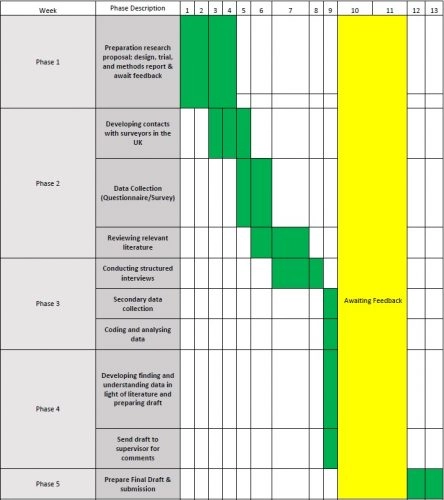Sample Masters Finance Dissertation Proposal
Here is a sample that showcases why we are one of the world’s leading academic writing firms. This assignment was created by one of our expert academic writers and demonstrated the highest academic quality. Place your order today to achieve academic greatness.
Impact Of the Global Financial Crisis 2008-2009 on the Uk Construction Industry and Quantity Surveyors
Introduction
Background
The 2008-2009 Great Recession or Global Financial Crisis is considered one of the worst economic events since the Great Depression of 1929 (Latham and Braun 2011). The crisis itself began in the United States with the subprime bubble popping in the mortgage sector, which eventually spread throughout Europe’s economies, catching on in Asia, South America and Africa.
The Global Financial Crisis (GFC) results are currently still in effect, with many subsequent events unfolding in real-time. These include the debt crisis of Greece and Spain. The financial upheaval has led to shortages in the stock markets, credit markets, decreased corporate profits and a rise in unemployment. The United Kingdom had officially entered into a recession in January 2009.
Since the onset of the recession, the UK’s gross domestic product (GDP) has sharply decreased in 2008 and continued to do so until 2009 (Atkins 2009). Peston (2008) asserted that the UK experienced the worst economic downturn since the Second World War. The construction industry in the UK was not immune to the worsening situation, eventually entering into the phase of deflation in 2008, with the industry still attempting to recover, only to be hit by the British Referendum 2016 (Brexit).
According to the Office of National Statistics (ONS) (2008), the construction industry’s revenue generation has fallen by 1.1 per cent during the fourth quarter of 2008. The resultant was the loss of massive jobs between 2009 and 2011 (ONS, 2015).
Problem Specification
The construction industry was badly affected by the GFC in 2008-2009. Evidence of this is presented in Sonson (2014), who states that new order in the construction industry had decreased by 39 per cent in the third quarter of 2008, a large reduction compared to that in 2007.
It is noted that during the time period, there was a reduction in private house order by 62 per cent on average, with public housing orders reducing by 36 per cent. According to ONS (2008), private housing orders began to fall in 2008 by 43 per cent and further decreased by 32 per cent in 2009. The industry saw a reduction in workload by 0.7 per cent in 2008. An additional decline in 2009 presented itself with 3.1 per cent (ONS 2008).
One of the most devastating impacts on the construction industry due to the events of GFC was decreasing salaries and excessive job cuts (Latham and Bruan 2011). Figures presented by Felstead et al. (2012) states that about 400,000 jobs in the construction industry were lost between 2009 and 2010.
Studies by Frei (2010), Hoxley (2010) and Dikeman et al. (2010) argue that both the private and public sector companies had significantly downsized and restructured themselves to survive the major impacts of the recession resulting in loss of resources about technical and expert human capital.
Many quantity surveyors experience the looming threat of recession, making their job quite redundant (Hoxley 2010). Consequently, quantity surveyors played an imperative role in recharging the construction industry through the recession and helping it grow once the economy was in recovery mode (Henry 2013).
Chiang et al. (2013), CIC (2013), and Henry (2013) agree that quantity surveyors play a critical role in ensuring that resources of the construction industry are used to the fullest extent for the company, industry and greater society. Chiang et al. (2013) 3mphasizes that quantity surveyors can be extremely useful for the financial management of projects, cost consultation services for clients and designers throughout the project’s lifecycle.
Quantity surveyors are important consultants for their employers in both the private and public sectors. The only difference between the two sectors is their use of the surveyors – for the private sector, that means focus on profit 3mphasizes3n. At the same time, the public 3mphasizes their use for accountability of public finance.
However, over the last few decades, both the private and public sectors have combined their differing aims to compete in the market with one another for construction projects, increased business and profit (Alfred 2007).
Considering the great importance placed on quantity surveyors in construction companies, it is essential to analyse the impact the economic recession may have on them.
Analysing their perspective can provide researchers with better insight on how to deal with catastrophes like the economic decline to stabilise markets and prepare them for impact since the GFC 2008-2009 researchers have focused on vast markets around the world to examine the factors causing the event and the immediate and long term consequences of it.
It is essential to investigate the crisis from a quantity surveyor’s eyes because of their crucial role in the construction industry. Based on preliminary research, the following primary research question has been developed.
How has the Great Financial Crisis of 2008-2009 impact quantity surveyors and the UK’s construction industry?
To help answer the primary research question, sub-questions were developed that are as follows;
1. What challenges did quantity surveyors experience in both the public and private sector during the financial crisis?
2. What was the role of quantity surveyors for public and private organisations during the financial crisis?
3. What are the strategies that quantity surveyors developed in both the public and private sector to prepare for future financial crises?
Research Aims and Objectives
The study’s primary aim is to analyse the impact of the financial crisis on the construction industry in the UK and quantity surveyors to understand the challenges and issues they faced to survive. To achieve this aim and answer the research questions, the following objectives have been developed.
1. Use primary and secondary data examine the impact of the financial crisis on the UK construction industry. This will include published government data from official websites like the Office of National Statistics (ONS) and conducting surveys throughout the public and private sector.
2. Examine the role that quantity surveyors played to mitigate the risk and threats imposed by the financial crisis on construction companies using primary research tools to gather data and then have it analysed.
3. Examine published academic literature that revolves around the topic of study to develop strong arguments throughout the thesis and use these gathered pieces of evidence to strengthen the premises current study.
Hire an Expert Dissertation Proposal Writer
Orders completed by our expert writers are
- Formally drafted in the academic style
- 100% Plagiarism-free & 100% Confidential
- Never resold
- Include unlimited free revisions
- Completed to match exact client requirements

Literature Review
The current study will use a systematic literature review to gather, organise, and examine existing literature. The purpose of using a systematic literature review allows the researcher to use vast-ranging literature in an organised manner (Cooper 2003).
According to Bem (1995) and Cooper (2003), the systematic literature review is efficient to recognise, evaluate, and incorporate published academic papers relevant to the study and address its research questions, aims, and objectives.
The current study aims to comprehend the relationship between quantity surveyors and their role during financial crises. This includes their strategies, their influence on the construction companies, and how financial crises may reciprocate surveyors’ influence. Randolph (2009) argues that systematic literature reviews can present relationships between topics by including contradictory material, identifying gaps in previous research, and even inconsistencies.
| Research Design | Mixed Methods Research (Realism) |
|---|---|
| Sampling Techniques | A total of 10 construction companies will be contacted, five from the public sector and five from the private sector. It is recommended that at least 20 quantity surveyors from each company be contacted to participate. Therefore a total of 200 quantity surveyors will be included in the study (N=200). At least one person from each company will be asked to participate in the semi-structured interview questions. |
| Data Collection | Quantitative: Likert Scale Questionnaire for Quantity Surveyors. Qualitative: Semi-structured interview questions. |
| Data Analysis | Quantitative: Descriptive Statistics, Factor Analysis, and Cronbach’s Alpha. Qualitative: Thematic Analysis |
Findings and Analysis
The chapter summarises the data collected and analysed based on the methods presented in the Methodology chapter. This includes charts, graphs, or other forms of illustrating the data to understand the presented arguments better.
Discussion and Conclusion
The chapter will conclude the entire dissertation and sum up the arguments that are being made. It will also include subsections on recommendations for further research and limitations that may have been presented in the study.
References
Alfred, O., 2007. Conflict of interest within construction practitioners: Quantity surveying, case study. Surveying and Built Environment, 18(1), pp. 35-50.
Atkins Group. 2009. Global construction outlook for 2009. International Construction Intelligence 21(1), pp. 1-6.
Bem, D., 1995. Writing a Review Article. Psychological Bulletin 118, 172–177.
Chiang, Y. H., Li, J., Choi, T. N. Y., Man, K. F. 2013. Evaluating construction contractors efficiency in Hong Kong using data envelopment analysis assurance region model. Journal of Facilities Management 11 (1), pp. 52-68.
Cooper, H., 2003. Psychological Bulletin: Editorial. Psychological Bulletin 129, 3–9.
Dikmen, I., Birgonul, M. T., Ozorhon, B., Space, N. E., 2010. Using the analytic network process to assess business failure risks on construction firms. Engineering, Construction and Architectural Management 17(4), pp. 369-386.
Felstead, A., Green, F., and Jewson, N. 2012. An analysis of the 2008-09 recession on the provision of training in the UK. Work Employment and Society, 26(6), pp. 968-986.
Frei, M., 2010. The implication of the global financial crisis for the quantity surveying profession. International Cost Engineering Council Publications [online]. Available at: http://www.icoste.org/Frei.pdf [Accessed: 30th May 2017].
Henry, L., 2013. Intellectual capital in a recession: evidence from UK SMEs. Journal of Intellectual Capital 14(1), pp. 84-101.
Hoxley, M., 2010. Built environment recession. Structural Survey 28(2), n.d.
Latham, S., and Braun, M., 2011. Economic recessions, strategy, and performance: A synthesis. Journal of Strategy and Management 4(2), pp. 96-115.
Lim, B. T. H., Oo, B. L., and Ling, F. 2010. The survival strategies of Singapore contractors in a prolonged recession. Engineering, Construction, and Architectural Management 17(4), pp. 387-403.
Office of National Statistics (ONS). 2008. Housing in England 2006/07: A report based on the 2006/07 survey of English housing carried out by the National Centre for Social Research. London: Department for Communities and Local Government.
Office for National Statistics (ONS). 2015. Output in the construction industry, August 2015 [online]. Available at: http://www.ons.gov.uk/ons/publications/re-reference-tables.html?edition=tcm%3A77-358530 [Accessed: 30th May 2017].
Peston, R., 2008. The new capitalism. BBC Report, 8th December [online]. Available at: http://www.wtf.org.uk/documents/thenewcapitalism_001.pdf. [Accessed: 30th May 2017].
Randolph, J.J., 2009. A Guide to Writing the Dissertation Literature Review. Practical Assessment, Research & Evaluation 14.
Sonson, S. J., 2014. Quantity surveying role and environment influences in Saint Lucia. PhD Thesis, University of Salford
Frequently Asked Questions
To write a Masters dissertation proposal:
- Choose a relevant topic.
- Provide context and background.
- State research questions and objectives.
- Outline the methodology.
- Include a literature review.
- Specify the significance of the study.






